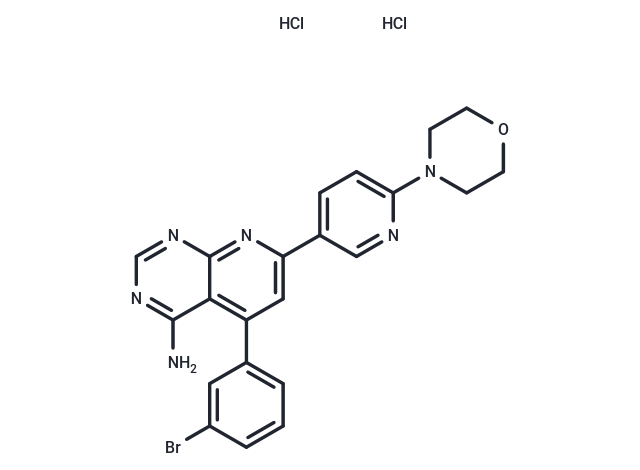购物车
- 全部删除
 您的购物车当前为空
您的购物车当前为空

ABT-702 dihydrochloride 是腺苷激酶抑制剂,IC50为1.7 nM。

ABT-702 dihydrochloride 是腺苷激酶抑制剂,IC50为1.7 nM。
| 规格 | 价格 | 库存 | 数量 |
|---|---|---|---|
| 1 mg | ¥ 472 | 现货 | |
| 5 mg | ¥ 1,230 | 现货 | |
| 10 mg | ¥ 1,980 | 现货 | |
| 25 mg | ¥ 3,370 | 现货 | |
| 50 mg | ¥ 4,780 | 现货 | |
| 100 mg | ¥ 6,680 | 现货 | |
| 200 mg | ¥ 8,820 | 现货 | |
| 1 mL x 10 mM (in DMSO) | ¥ 1,460 | 现货 |
| 产品描述 | ABT-702 dihydrochloride is a potent adenosine kinase (AK) inhibitor. |
| 靶点活性 | Adenosine kinase:1.7nM |
| 体外活性 | ABT-702 is an orally effective adenosine kinase inhibitor that has several orders of magnitude selectivity over other sites of adenosine (ADO) interaction (A1, A2A, A3 receptors, ADO transporter, and ADO deaminase). ABT-702 is equipotent (IC50=1.5±0.3 nM) in inhibiting native human AK (placenta), two human recombinant isoforms (AKlong and AKshort), and AK from monkey, dog, rat, and mouse brain.ABT-702 also potently inhibits AK activity in intact cultured IMR-32 human neuroblastoma cells (IC50=51 nM), indicating that ABT-702 can penetrate the cell membrane and potently inhibit AK at its intracellular site. |
| 体内活性 | Rats are given an intraperitoneal injection of the adenosine A1 receptor antagonist DPCPX (3 mg/kg), ABT-702 (3 mg/kg), or vehicle 10 minutes prior to an intravenous injection of 2-18F-fluorodeoxy-D-glucose (FDG) (FDG, 15.4±0.7 MBq per rat). Rats are then subjected to a 15 minute static positron emission tomography (PET) scan. Reconstructed images are normalized to FDG PET template for rats and standard uptake values (SUVs) are calculated. To examine the regional effect of active treatment compared to vehicle, statistical parametric mapping analysis is performed. Whole-brain FDG uptake is not affected by drug treatment. Significant regional hypometabolism is detected, particularly in cerebellum, of DPCPX and ABT-702 treated rats, relative to vehicle-treated rats. Thus, endogenous adenosine can affect FDG accumulation although this effect is modest in quiescent rats. Body weight (316.8±28.4 g; mean±SD) and blood glucose (5.5±1.7 mM) are not significantly different among three groups. Whole-brain PET SUV values are 1.6±0.4, 1.6±0.6, and 1.8±0.6 for vehicle, ABT-702, and DPCPX-treated rats, respectively (F(2,9)=0.298, P=0.75). statistical parametric mapping (SPM) analysis reveals significant regional hypometabolism in the cerebellum, mesenceph.ABT-702 significantly reduces acute thermal nociception in a dose-dependent manner after both intraperitoneal (ED50=8 μmol/kg i.p.) and oral (ED50=65 μmol/kg p.o.) administration in the mouse hot-plate test. Consistent with its antinociceptive effects in the hot-plate assay, ABT-702 also produces dose-dependent antinociceptive effects (ED50=2 μmol/kg i.p.) in the abdominal constriction assay. |
| 动物实验 | Rats are fasted for 16 hours prior to use. At the beginning of the experiment, each rat is weighed, and then anesthetized using 5% isoflurane for induction and 2.5% for maintenance. A blood sample from tail vein is collected for a fasting blood glucose determination using a standard glucometer. Rats are then given an intraperitoneal (i.p.) injection of DPCPX (3 mg/kg, n=4), ABT-702 (3 mg/kg, n=4), or an equivalent volume of vehicle (15% dimethyl sulfoxide, 15% cremophor EL, 70% saline, n=4) to manipulate the effect of endogenous adenosine on neuronal activities. Ten minutes after i.p. injection, rats are administered FDG (15.4±0.7 MBq) in 0.3-0.5 mL saline by intravenous (i.v.) tail vein injection. Rats are allowed to recover from anesthesia after the FDG injection but are reanesthetized for 15-minute-static PET scan with the head in the center of the field of view. |
| 分子量 | 536.25 |
| 分子式 | C22H21BrCl2N6O |
| CAS No. | 1188890-28-9 |
| Smiles | Cl.Cl.Nc1ncnc2nc(cc(-c3cccc(Br)c3)c12)-c1ccc(nc1)N1CCOCC1 |
| 密度 | no data available |
| 存储 | Powder: -20°C for 3 years | In solvent: -80°C for 1 year | Shipping with blue ice. | ||||||||||||||||||||||||||||||
| 溶解度信息 | DMSO: 45 mg/mL (83.91 mM) | ||||||||||||||||||||||||||||||
溶液配制表 | |||||||||||||||||||||||||||||||
| |||||||||||||||||||||||||||||||
评论内容